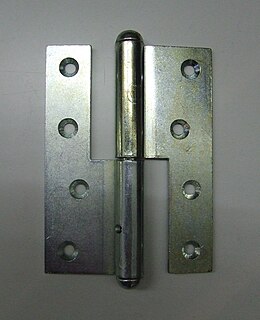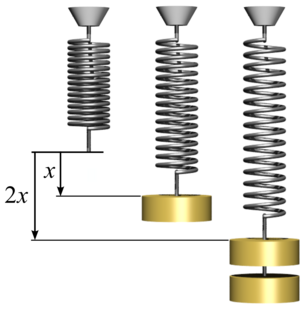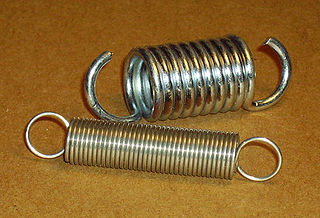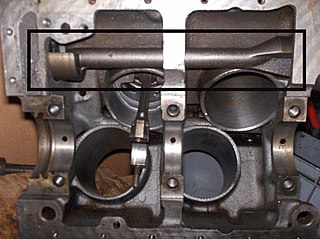This article needs additional citations for verification .(June 2016) (Learn how and when to remove this template message) |
In engineering, iso-elastic refers to a system of elastic and tensile parts (springs and pulleys) which are arranged in a configuration which isolates physical motion at one end in order to minimize or prevent similar motion from occurring at the other end. This type of device must be able to maintain angular direction and load-bearing over a large range of motion.
In physics, elasticity is the ability of a body to resist a distorting influence and to return to its original size and shape when that influence or force is removed. Solid objects will deform when adequate forces are applied to them. If the material is elastic, the object will return to its initial shape and size when these forces are removed. Hooke's law states that the force should be proportional to the extension. The physical reasons for elastic behavior can be quite different for different materials. In metals, the atomic lattice changes size and shape when forces are applied. When forces are removed, the lattice goes back to the original lower energy state. For rubbers and other polymers, elasticity is caused by the stretching of polymer chains when forces are applied.
The most prominent use of an iso-elastic system is in the supporting armature of a Steadicam, used to isolate a film or video camera from the operator's movements. Steadicam arms all work in a fashion similar to a spring lamp since each arm has two sections (similar to and labelled like a human arm); both the upper and fore-arm sections consist of a parallelogram with a diagonal iso-elastic cable-pulley-spring system. The iso-elastic system is tensioned to counteract the weight of the camera and steadicam sled. This tensioning allows the camera and operator to move vertically and independently of each other. For example, as the operator runs, the bouncing of his body is absorbed by the springs, keeping the camera steady. The arm also has unsprung hinges at both ends of each arm allowing it to bend in the horizontal plane (just like your elbow, not like a spring lamp).

Steadicam is a brand of camera stabilizer mounts for motion picture cameras invented by Garrett Brown and introduced in 1975 by Cinema Products Corporation. It mechanically isolates the operator's movement, allowing for a smooth shot, even when the camera moves over an irregular surface.

In Euclidean geometry, a parallelogram is a simple (non-self-intersecting) quadrilateral with two pairs of parallel sides. The opposite or facing sides of a parallelogram are of equal length and the opposite angles of a parallelogram are of equal measure. The congruence of opposite sides and opposite angles is a direct consequence of the Euclidean parallel postulate and neither condition can be proven without appealing to the Euclidean parallel postulate or one of its equivalent formulations.

A hinge is a mechanical bearing that connects two solid objects, typically allowing only a limited angle of rotation between them. Two objects connected by an ideal hinge rotate relative to each other about a fixed axis of rotation: all other translations or rotations being prevented, and thus a hinge has one degree of freedom. Hinges may be made of flexible material or of moving components. In biology, many joints function as hinges like the elbow joint.
To understand how an iso-elastic system works, we must first understand how springs work. The tension (elastic force) in a spring is proportional to its extension according to Hooke's law. This means that if a weight is hung on a spring it will oscillate with simple harmonic motion about its balance point; when the weight is above the balance point the spring's tension is reduced so the weight falls due to gravity, and when the weight is below the balance point the spring's tension will pull it back upwards.

Hooke's law is a law of physics that states that the force needed to extend or compress a spring by some distance x scales linearly with respect to that distance. That is: , where k is a constant factor characteristic of the spring: its stiffness, and x is small compared to the total possible deformation of the spring. The law is named after 17th-century British physicist Robert Hooke. He first stated the law in 1676 as a Latin anagram. He published the solution of his anagram in 1678 as: ut tensio, sic vis. Hooke states in the 1678 work that he was aware of the law already in 1660.
In mechanics and physics, simple harmonic motion is a special type of periodic motion or oscillation where the restoring force is directly proportional to the displacement and acts in the direction opposite to that of displacement.
If a simple spring system were used in a steadicam, then as the operator moved vertically, the camera would be subject to simple harmonic motion, and bounce up and down. To counteract this tendency, an iso-elastic system is employed.
The springs used are large, stiff springs with a high modulus of elasticity, and they are highly tensioned. A compound pulley system is then used so that the large force exerted by the spring can be divided by a factor of five, for example, so the cable exiting the pulley system will have only moderate tension. Most importantly, however, when the cable is drawn in or out the extension of the spring changes by only a fifth of that distance, so that the tension force of the spring will not change much. The result is that the spring-pulley system can produce a fairly constant tension in the cable over a large range of movement.

A pulley is a wheel on an axle or shaft that is designed to support movement and change of direction of a taut cable or belt, or transfer of power between the shaft and cable or belt. In the case of a pulley supported by a frame or shell that does not transfer power to a shaft, but is used to guide the cable or exert a force, the supporting shell is called a block, and the pulley may be called a sheave.
The almost constant force exerted by an iso-elastic system is employed in the armature of a steadicam, to counteract the constant force of gravity on the camera's and mount's mass. The result is that the weight of the camera is almost exactly balanced by the tension force throughout the entire range of vertical movement, so even when the operator jumps vertically, the camera will retain its vertical position due to inertia, but remain balanced, just with the armature at a different angle.

Gravity, or gravitation, is a natural phenomenon by which all things with mass or energy—including planets, stars, galaxies, and even light—are brought toward one another. On Earth, gravity gives weight to physical objects, and the Moon's gravity causes the ocean tides. The gravitational attraction of the original gaseous matter present in the Universe caused it to begin coalescing, forming stars—and for the stars to group together into galaxies—so gravity is responsible for many of the large-scale structures in the Universe. Gravity has an infinite range, although its effects become increasingly weaker on farther objects.

Mass is both a property of a physical body and a measure of its resistance to acceleration when a net force is applied. An object's mass also determines the strength of its gravitational attraction to other bodies.
In science and engineering, the weight of an object is related to the force acting on the object, either due to gravity or to a reaction force that holds it in place.
As a result, the camera doesn't bounce up to the 'balanced' position after a move, for example when the operator steps up onto a curb from the road. This allows the camera to be more isolated and independent of the operator's moves. The operator can of course deliberately move the camera up or down, if desired. In reality however camera operators find it preferable for the arm to not be perfectly iso-elastic so that the camera will naturally rise to a comfortable operating height; the springs will be tensioned so this only happens very slowly and without bouncing so as to maintain the smoothness of the camera's motion." [1]












